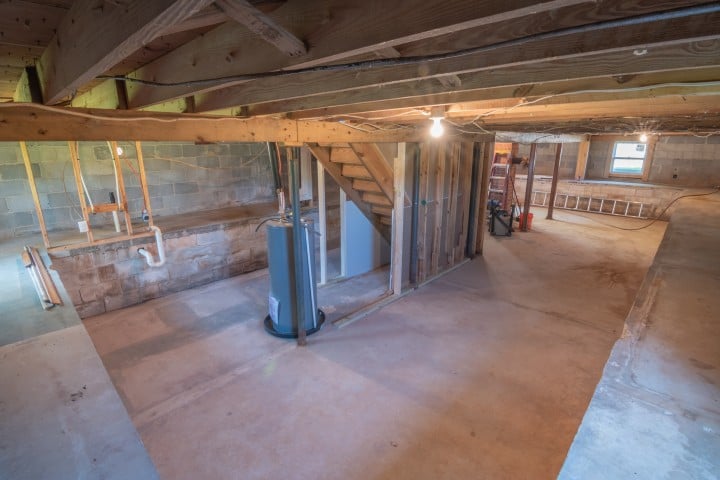Everyone knows the basement can be damp and chilly, especially in the colder months. That makes people not want to spend much time down there, even if it’s finished. But that also makes people miss out on enjoying a big part of their home. The basement is for more than just doing the laundry. It’s a good place to add living space, like a rec room or second living room.
If your basement is freezing during the fall and winter, here are some ways to warm it up.
Insulation
If you’re finishing your basement to create a TV room, exercise area, or another bedroom, take the opportunity to insulate the walls. Insulation that’s rated R-10 to R-19 is suitable. Spray foam is good for insulating basement walls to keep out the draft and keep warm air in. You can add insulation to the walls, floor, and ceiling and seal any gaps around windows and doors. A thermal-imaging camera can help you identify cold spots where outside air leaks in. You can then take steps like caulking windows, sealing cracks, or adding insulation.
A licensed contractor is needed to make sure the insulation is completed correctly. Be sure to address any water leaks in the walls or floor.
Also, the first-floor walls need to be insulated because cold air coming in the first floor will descend into the basement.
Extend the Existing HVAC and Ductwork
If your basement is already complete, it may not be cost-effective to tear down the walls to add more insulation. Another way to provide heat is to extend the ductwork of your existing heating system to the basement. The ductwork may already be visible and accessible from the basement. The ductwork can be modified to add heat vents to the basement. You will want to work with a qualified HVAC professional, who can help calculate the hearing load and size and determine the proper ductwork layout.
Speaking of ductwork, these pipes are often not insulated and so can bring cold air into the home. Consider wrapping existing metal ducts with insulation or replacing them with insulated ducts.
Heat Sources
You can also install heat sources in the basement to provide heat. You must be careful, though, as some of these can get very hot. Some options are:
Space Heater
A portable electric space heater is an effective and economical solution. While one space heater may not warm up the entire basement, it can provide enough heat for a single room. Space heaters are inexpensive and easy to set up and operate. Space heaters include convection heaters, flat, wall-mounted heaters, and portable radiators.
Ductless Mini-Split Heater
This is a unit that connects directly to an outdoor compressor without need for any ductwork. They are expensive to install, but are very effective at heating and cooling a large area like the basement. Most serve dual purposes: they can be used as air conditioners in the summer.
Wall Heaters
Wall heaters are installed in the wall and heat air from outside. They run on propane or natural gas and are vented through the roof or wall. Electric wall heaters are also available. These don’t need vents, but are best for heating a specific location instead of the entire basement.
Baseboard Heaters
Baseboard heaters are long, portable units that run along the baseboard at the foot of a wall. They do not have to cover the entire wall; you can determine how much heat you need and get the appropriate length. Some baseboard heaters plug into a wall outlet, while others must be hard-wired into the home circuitry.
Electric Fireplace
An electric fireplace provides both warmth and beauty to a finished basement. Electric fireplaces can be recessed or wall-mounted and come in various widths.
Radiant Floor Heater
A radiant floor heater is like a heated mat. Though expensive, they are one of the most effective ways to heat your basement. They can be installed during construction or a basement renovation and come in different sizes.
Radiant Wall Heater
A wall-mounted heater can also provide heat by convection. It’s thin and inconspicuous but can heat a room.
Wood Pellet Stove
A wood pellet stove burns manufactured wood pellets and distributes the heat using a small fan. It’s a greener alternative to a conventional wood-burning stove. The recycled pellets burn slowly and the stove just needs to be plugged into a wall to run the fan. However, the stove produces carbon monoxide and must be vented to the outside.
Other Solutions
Here are some other ways to add warmth to your basement:
- Add carpeting or area rugs on the floor
- Turn ceiling fans clockwise to spread warm air
- Consider replacing older windows and doors with energy-efficient ones
- Install thermal curtains to keep heat in
We hope you found this post, Best Way to Heat a Basement, useful. Be sure to check out our post, How to Turn Your Damp Basement to a Dream Living Space for more great information.
Have Experience in the Moving Industry? Want an Additional Income Stream? Work With All Around Moving!
All Around Moving’s Work With Us program, gives the experienced moving consultants with the option to run their own Relocation Consultant business from any city.
A nominal one-time start-up fee of $275.00, gives you the “key” to have your business up and running at no time. There is $125.00 monthly recurring expense, and the cost of purchasing your own type of leads you want to work on. We share profits 50-50 with you from all jobs you book with us. Click here to learn more.






